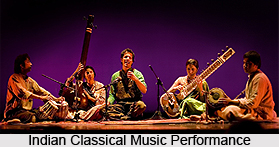 In India, the word alankara or alankar means adornments or ornaments. In the context of Indian Classical Music, the use of alankara is basically to enhance and embellish the internal beauty of the genre. The initial reference to the term alankara was first found in Bharata`s Natyashastra written sometime between 200 BC and 200 AD. This particular treatise on dance drama mentions 33 types of Alankars. Other musical treatise like Sharangdev`s Sangeet Ratnakar that originated in thirteenth century, and Ahobal`s Sangeet Parijat in seventeenth century mention, around 63 and 68 types of Alankars respectively.
In India, the word alankara or alankar means adornments or ornaments. In the context of Indian Classical Music, the use of alankara is basically to enhance and embellish the internal beauty of the genre. The initial reference to the term alankara was first found in Bharata`s Natyashastra written sometime between 200 BC and 200 AD. This particular treatise on dance drama mentions 33 types of Alankars. Other musical treatise like Sharangdev`s Sangeet Ratnakar that originated in thirteenth century, and Ahobal`s Sangeet Parijat in seventeenth century mention, around 63 and 68 types of Alankars respectively.
The ancient text or Shastras have actually categorized Alankars into two major groups; Shabdalankar and Varnalankar. The latter comprised of varna which were based on alankars of ancient times. The four types of varna includes arohi, avarohi, sthayi and sanchari. Sthayi alankar refers to stopping at a single note, arohi to an upward movement, avarohi to downward movement and sanchari refers to mixed movements (both upward and downward). This classification of alankars relate to the structural aspect of raga.
The Shandalankar comprise of the aesthetic aspect. It refers to the technique of sound production used by either instrument or human voice. All types of extempore and improvisation that an artist performs on stage within the tala and raga limits are termed as alankars. This actually enhances the beauty of raga and tala composition.
Over the years, going by the performances, practices, audio and printed materials, personal views of musicologist, musicians collected for the last 150 years actually goes to show that the idea and definition of shabdalankars have changed drastically. Besides the raga, the rendition of bandish and tala, which are the fixed component of a performance, has been segregated into various divisions and stages as well. These stages actually comprise of alaap-vistaar, bol-bant, behalawa, sargams, tans, drut laya and vilambit laya in case of alaap and khayal, gats and jod in case of the instrumental music. They vary from one gharana to another.
In Indian classical genre and especially in raga sangeet, straight or staccato isolated notes are completely unheard of. Each note has a link with succeeding and preceding note. It is this extra grace that actually lays the foundation for the alankars. The shrutis are important aspect in raga sangeet demand the noble nature of swaras in Indian music.
In Shastras, a basic note has been referred to as alankarik swar. When a cluster or group of notes meets another swar, they form alankarik pad. The commonly used alankars comprise of Meend, Kan, Sparsh, Andolan, Gamak, Kampit, Gitkari, Khatka, Murki, Zamzama and Krintan. The definition of alankarik genre has varied definition, though it is widely accepted but not considered to be completely authentic. There are various illustration and interpretations that are available for alankarik swar which varies from gharana to gharana.




















